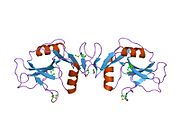- OLR1
-
Oxidized low-density lipoprotein receptor 1 (Ox-LDL receptor 1) also known as lectin-type oxidized LDL receptor 1 (LOX-1) is a protein that in humans is encoded by the OLR1 gene.[1][2]
Contents
Function
LOX-1 is a receptor protein which belongs to the C-type lectin superfamily. Its gene is regulated through the cyclic AMP signaling pathway. The protein binds, internalizes and degrades oxidized low-density lipoprotein. This protein may be involved in the regulation of Fas-induced apoptosis. This protein may play a role as a scavenger receptor.[2]
Clinical significance
Mutations of the OLR1 gene have been associated with atherosclerosis, risk of myocardial infarction, and may modify the risk of Alzheimer's disease.[2] Berberine inhibits ORL1 (LOX-1)with the improvement in hemoglobin A1c and AGEs in diabetics. Berberine hence protects against endothelial injury and enhances the endothelium-dependent vasodilatation, which is mediated in part through activation of the AMPK signaling cascade.[3]
References
- ^ Li X, Bouzyk MM, Wang X (Nov 1998). "Assignment of the human oxidized low-density lipoprotein receptor gene (OLR1) to chromosome 12p13.1→p12.3, and identification of a polymorphic CA-repeat marker in the OLR1 gene". Cytogenet Cell Genet 82 (1–2): 34–6. doi:10.1159/000015059. PMID 9763655.
- ^ a b c "Entrez Gene: OLR1 oxidized low density lipoprotein (lectin-like) receptor 1". http://www.ncbi.nlm.nih.gov/sites/entrez?Db=gene&Cmd=ShowDetailView&TermToSearch=4973.
- ^ Wang Y, Huang Y, Lam KS, Li Y, Wong WT, Ye H, Lau CW, Vanhoutte PM, Xu A (June 2009). "Berberine prevents hyperglycemia-induced endothelial injury and enhances vasodilatation via adenosine monophosphate-activated protein kinase and endothelial nitric oxide synthase". Cardiovasc. Res. 82 (3): 484–92. doi:10.1093/cvr/cvp078. PMID 19251722.
Further reading
- Sawamura T (2002). "[Molecular identification of LOX-1 and analysis of its pathophysiological role]". Nippon Yakurigaku Zasshi 119 (3): 145–54. doi:10.1254/fpj.119.145. PMID 11915516.
- Mehta JL, Li D (2002). "Identification, regulation and function of a novel lectin-like oxidized low-density lipoprotein receptor". J. Am. Coll. Cardiol. 39 (9): 1429–35. doi:10.1016/S0735-1097(02)01803-X. PMID 11985903.
- Sawamura T (2002). "[LOX-1: the oxidized LDL receptor expressed in vascular endothelial cells]". Seikagaku 74 (5): 365–76. PMID 12073608.
- Ando K, Fujita T (2005). "Role of lectin-like oxidized low-density lipoprotein receptor-1 (LOX-1) in the development of hypertensive organ damage". Clin. Exp. Nephrol. 8 (3): 178–82. doi:10.1007/s10157-004-0288-9. PMID 15480893.
- Sawamura T, Kume N, Aoyama T, et al. (1997). "An endothelial receptor for oxidized low-density lipoprotein". Nature 386 (6620): 73–7. doi:10.1038/386073a0. PMID 9052782.
- Yoshida H, Kondratenko N, Green S, et al. (1998). "Identification of the lectin-like receptor for oxidized low-density lipoprotein in human macrophages and its potential role as a scavenger receptor". Biochem. J. 334 ( Pt 1) (Pt 1): 9–13. PMC 1219654. PMID 9693095. http://www.pubmedcentral.nih.gov/articlerender.fcgi?tool=pmcentrez&artid=1219654.
- Mehta JL, Li DY (1998). "Identification and autoregulation of receptor for OX-LDL in cultured human coronary artery endothelial cells". Biochem. Biophys. Res. Commun. 248 (3): 511–4. doi:10.1006/bbrc.1998.9004. PMID 9703956.
- Yamanaka S, Zhang XY, Miura K, et al. (1999). "The human gene encoding the lectin-type oxidized LDL receptor (OLR1) is a novel member of the natural killer gene complex with a unique expression profile". Genomics 54 (2): 191–9. doi:10.1006/geno.1998.5561. PMID 9828121.
- Nagase M, Abe J, Takahashi K, et al. (1999). "Genomic organization and regulation of expression of the lectin-like oxidized low-density lipoprotein receptor (LOX-1) gene". J. Biol. Chem. 273 (50): 33702–7. doi:10.1074/jbc.273.50.33702. PMID 9837956.
- Draude G, Hrboticky N, Lorenz RL (1999). "The expression of the lectin-like oxidized low-density lipoprotein receptor (LOX-1) on human vascular smooth muscle cells and monocytes and its down-regulation by lovastatin". Biochem. Pharmacol. 57 (4): 383–6. doi:10.1016/S0006-2952(98)00313-X. PMID 9933026.
- Aoyama T, Sawamura T, Furutani Y, et al. (1999). "Structure and chromosomal assignment of the human lectin-like oxidized low-density-lipoprotein receptor-1 (LOX-1) gene". Biochem. J. 339 ( Pt 1) (Pt 1): 177–84. doi:10.1042/0264-6021:3390177. PMC 1220142. PMID 10085242. http://www.pubmedcentral.nih.gov/articlerender.fcgi?tool=pmcentrez&artid=1220142.
- Li DY, Zhang YC, Philips MI, et al. (1999). "Upregulation of endothelial receptor for oxidized low-density lipoprotein (LOX-1) in cultured human coronary artery endothelial cells by angiotensin II type 1 receptor activation". Circ. Res. 84 (9): 1043–9. PMID 10325241.
- Kataoka H, Kume N, Miyamoto S, et al. (1999). "Expression of lectinlike oxidized low-density lipoprotein receptor-1 in human atherosclerotic lesions". Circulation 99 (24): 3110–7. PMID 10377073.
- Li D, Saldeen T, Romeo F, Mehta JL (2000). "Oxidized LDL upregulates angiotensin II type 1 receptor expression in cultured human coronary artery endothelial cells: the potential role of transcription factor NF-kappaB". Circulation 102 (16): 1970–6. PMID 11034947.
- Bull C, Sobanov Y, Röhrdanz B, et al. (2001). "The centromeric part of the human NK gene complex: linkage of LOX-1 and LY49L with the CD94/NKG2 region". Genes Immun. 1 (4): 280–7. doi:10.1038/sj.gene.6363678. PMID 11196705.
- Shi X, Niimi S, Ohtani T, Machida S (2001). "Characterization of residues and sequences of the carbohydrate recognition domain required for cell surface localization and ligand binding of human lectin-like oxidized LDL receptor". J. Cell. Sci. 114 (Pt 7): 1273–82. PMID 11256994.
- Chen M, Narumiya S, Masaki T, Sawamura T (2001). "Conserved C-terminal residues within the lectin-like domain of LOX-1 are essential for oxidized low-density-lipoprotein binding". Biochem. J. 355 (Pt 2): 289–96. doi:10.1042/0264-6021:3550289. PMC 1221738. PMID 11284714. http://www.pubmedcentral.nih.gov/articlerender.fcgi?tool=pmcentrez&artid=1221738.
- Tanimoto A, Murata Y, Nomaguchi M, et al. (2001). "Histamine increases the expression of LOX-1 via H2 receptor in human monocytic THP-1 cells". FEBS Lett. 508 (3): 345–9. doi:10.1016/S0014-5793(01)03073-3. PMID 11728449.
- Sobanov Y, Bernreiter A, Derdak S, et al. (2002). "A novel cluster of lectin-like receptor genes expressed in monocytic, dendritic and endothelial cells maps close to the NK receptor genes in the human NK gene complex". Eur. J. Immunol. 31 (12): 3493–503. doi:10.1002/1521-4141(200112)31:12<3493::AID-IMMU3493>3.0.CO;2-9. PMID 11745369.
PDB gallery 1ypo: Human Oxidized Low Density Lipoprotein Receptor LOX-1 P3 1 21 Space Group1ypq: Human Oxidized Low Density Lipoprotein Receptor LOX-1 Dioxane Complex1ypu: Human Oxidized Low Density Lipoprotein Receptor LOX-1 C2 Space Group1yxj: Crystal structure of human lectin-like oxidized low-density lipoprotein receptor 1 (LOX-1) at low pH1yxk: Crystal structure of human lectin-like oxidized low-density lipoprotein receptor 1 (LOX-1) disulfide-linked dimerCategories:- Human proteins
- C-type Lectins
- Chromosome 12 gene stubs
Wikimedia Foundation. 2010.







